1. Finding The Right Detail
For decades, researchers have tried to date the Voynich Manuscript by examining fragmentary details apparently depicted in its shapes, such as…
- The baths in Quire 13 (‘Q13’) – (are these the Bagno di Romana?)
- The Sagittarius crossbow and his clothes, etc
- The Q9 and Q13 wolkenbanden [see the letters on p.50 & p.54 of the linked PDF]
- The hairstyles of the zodiac ‘nymphs’
- The pots in the early zodiac pages (are these maiolica albarelli?)
All of which is sensible historical research into its art, but not actually Art History per se.
You see, Art History practitioners view their discipline as a forensic anthropology of the mark – a rigorous study of the ways in which rendering techniques (such as the line, the brush-stroke, the cut, etc) flow between artists’ minds. Their focus on continuity-through-technique is consciously shared by intellectual historians, whose discipline extends Art History’s remit to encompass the idea behind all forms of human culture, and hence traces ideas flowing through time.
Contrast this with the (say) pre-1970 emphasis on iconographic patronage (how artists supposedly used deep-rooted patterns of thought and mythology to flatteringly represent things important to their patrons), which has rather faded. Modern art historians are less prone to swallow Giorgio Vasari’s tall tales, and are more likely to instead look at incidental documentation (such a letters, appearances in court, financial records, etc) when trying to build up a picture of a given artist’s context. But even they can be unreliable – documents don’t have to be written by Vasari to have an agenda. 🙂
And so we have reached a situation where art historians prefer to focus not on that-which-is-depicted (which, as we have seen all too often with the Voynich Manuscript, is subject to an infinity of interpretations, regardless of whether you believe they also have a symbolic dimension) but on that-which-is-performed, the forensics of the mark. Essentially, when a styled mark is made, art historians ask: from where did the idea for using that style come? And to where did it go?
The problem with the VMs is working out which mark to use. After all, we have literally hundreds of pages full of possible candidate marks to select from. After going down hundreds of blind alleys over the past few years, I think I’ve now identified the key styled mark to focus upon – parallel hatching.
2. The History Of Parallel Hatching
Anyone familiar with the drawings in Leonardo da Vinci’s (1452-1509) famous notebooks should recognize parallel hatching immediately. It is a line-drawing technique for expressing mid-tones though the use of closely spaced parallel lines that was very popular in Florence (where Leonardo learnt to draw) in the second half of the 15th century. You can also see it in the drawings of countless other Florentines of the same period, such as Michelangolo Buonaroti.
Several years ago, I heard it mentioned in a lecture that parallel hatching emerged in Florence circa 1440. (I’ll add links to any examples I find here). The technique then spread to Venice around 1450, and from there to the rest of Europe. In a post here last November, I mentioned a good example of this: if you look at the vignettes in the corners of the 1452 mappa mundi by Giovanni Leardo, you can see some parallel hatching there, whereas Leardo’s 1442 and 1448 mappae mundi have no parallel hatching at all.
Around this time, artists looked for ways to give the new medium of engraving more subtelty: perhaps most notable of these is Master E. S. (formerly known as “the Master of 1466”), a German goldsmith and engraver, who is thought to have created in the period 1450-1467 around 200-500 engravings, many with well-developed cross-hatching (two overlaid sets of parallel hatches).
But cross-hatching only became fashionable somewhere between 1465 and 1489 (opinions vary), with Florentine goldsmith and sculptor Antonio Pollaiuolo’s epic engraving “Battle of the Nudes“. Prints of his Battle rapidly circulated around Italy and Europe, and were both much admired and much copied, introducing the idea of cross-hatch to a much wider audience, as well as Pollauiuolo’s own deft brand of zigzag hatching. This is how cross-hatching and zigzag hatching came to be picked up by many artists of this period.
Yet beyond about 1500-1510, this whole artistic vogue for parallel hatching – right at the zenith of which Leonardo had been born – faded completely away. Because of the introduction of new paints and writing materials, there were numerous far easier ways for artists to represent mid-tones directly in their sketches: and so hatching became technically redundant. A significant reason for the distinctive style used in Leonardo’s notebooks, then, simply arose from his having been born in the right place (Florence) and at the right time (circa 1450) to become its most famous exponent.
As for the origins of parallel hatching, the most favoured answer currently seems to be that these lay in niello, a technique favoured by mid-Quattrocento Florentine goldsmiths. There, pieces of jewellery have shapes engraved into their surface with a burin (a round-handled chisel), and the resulting grooves are filled in with the niello itself, which is a dark-coloured mixture of silver, lead and sulphur. This gives the engraved shapes a distinctive (and quite attractive) high-contrast look. Though the basic technique had been common in the Ukraine in the 13th century, it was Florentine goldsmiths who introduced parallel hatching to the conceptual toolbox of niello techniques – this enabled mid-tones to be rendered in the (otherwise bitonal) medium.
This is why the goldsmith-turned-printmaker career trajectories of Master E. S. and Antonio Pollaiuolo are of so much interest to art historians – for without experience in making niello pieces, would either [the reasoning goes] have ever made the necessary conceptual leaps (to cross-hatching and zigzag hatching) for the new medium?
3. Parallel Hatching In The Voynich Manuscript
What, then, of the Voynich Manuscript? A careful examination of the Beinecke Library’s online scans reveals that parallel hatching (but not any other form of hatching) appears in a number of separate places:-
These examples of hatching all seem integral to the conception and execution of their respective drawings: and hence there seems no reason to infer that any of them was added by a later owner. Quite apart from the thorny issue of what these various drawings depict, can we say with strong certainty that these marks are parallel hatching? I think the answer is yes: and I hope you agree.
4. The Voynich Manuscript’s Earliest Date
With the above evidence in mind, I contend that it would seem highly improbable to an art historian that the parallel hatching in the Voynich Manuscript is anything apart from, well, parallel hatching. And because the whole idea of parallel hatching seems to have originated with Florentine goldsmiths working in niello and/or printmaking in the 1440s before spreading to Venice, Germany and the rest of Europe around 1450, we can comfortably place 1440 as the Voynich Manuscript’s earliest date if it was made in Florence, or 1450 otherwise.
Furthermore, given that parallel hatching died out not long after the end of the fifteenth century, it seems probable (if not quite as certain) that the Voynich Manuscript originated during the same 1440-1510 period that saw the hatching flourish, with a more likely date range (from the lack of cross-hatching or zigzag hatching) being 1450-1480.
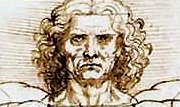
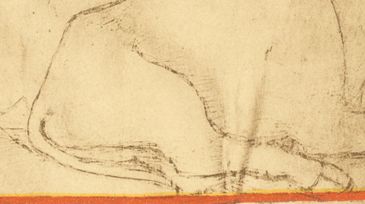
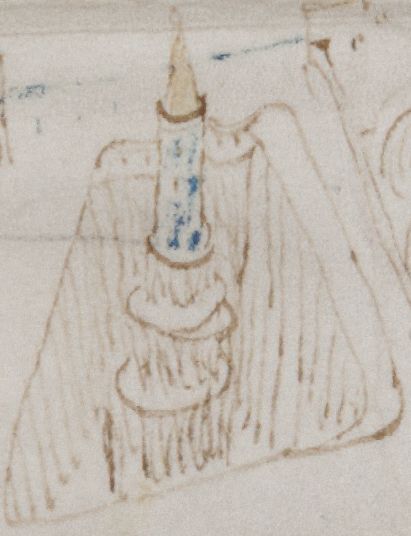
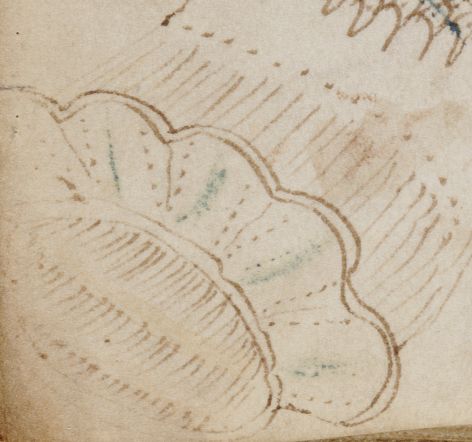
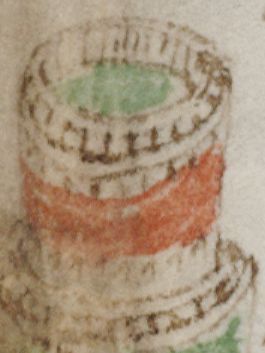
Nick, A fine bit of art history research. The VM herbal section abounds with parallel hatching. It seems in use on protrusions on flowers and blossoms but particularly on fat roots to indicate a bit of three dimensionality, sort of a rounded quality. It seems possible that it might have arisen outside of Florence and maybe even, dare I say it, Italy? How else would a draftsman or artist indicate a 3D quality? Cheers, Tom
Tom: although any given artistic technique could have been used by anyone at any time in history, Art History points out that techniques almost always flow sequentially from artist to artist. The obvious corollary is that if you can’t find any pre-1475 examples of parallel hatching outside of Italy / Germany / Switzerland, then the chances of the VMs having been made anywhere else are significantly smaller. But you knew that already! 🙂
The obvious corollary is that if you can’t find any pre-1475 examples of parallel hatching outside of Italy / Germany / Switzerland, then the chances of the VMs having been made anywhere else are significantly smaller.
Indeed.
The corollary to which being, that if you can and do..
I still like this post.
Diane
Looking through the manuscript I am very hard pressed to find anything that looks like a parallel hatching technique to show shading. There are a lot of areas where there are parallel lines but they all appear to be illustrating textures.
Markis: without knowing the artist’s intentions on the nine rosette page (which is replete with parallel hatching) or, say, on f102r2, it’s hard to say either way. But the Art History point remains that we don’t see the systematic use of parallel lines within illustrations for any reasons before about 1410 (German playing cards), 1440 (Florence), or 1450 (Venice, and then the rest of Northern Italy) – whether individual cases use parallel hatching for the purpose of achieving a shading effect or for fine illustrative detail is perhaps a separate question.
Nick,
what you say could be true, under certain conditions
1. that by “art history” is meant no art history except that of Latin Europe
2. that the manuscript’s content (as distinct from its place of manufacture – though that too is unknown) had been previously proven exclusively the original product of Latin Europe.
3. that even if we accepted that all art history was European art history, and that all the content had been proven the original work of a Latin European, that no earlier examples of the use of near-parallel lines had been found earlier anywhere else in Latin Europe.
As it is you are attempting to prove a Latin renaissance provenance by defining what you see from an assumption that a Latin renaissance provenance has already been proven.
If as careless an argument were proffered in relation to the written text, I doubt you’d entertain it.
I’m not saying this to bait you, but this cornerstone of your argument simply isn’t valid – and as a number of people have tried to let you know over the years, your definition of ‘parallel hatching’ is not actually what is meant when we use the term in art history – not even within the very narrow limits of the history of European graphic art. ‘hatching’ doesn’t include any and all forms of parallel and near-parallel lines. I don’t expect you’ll hear this as any genuine effort to correct a long-standing misapprehension, but I believe this item is really blocking your appreciation of the work, which deserves more appreciation than it generally receives.
Diane: you’re baiting, and it’s boring.
Please don’t use my blog to howl at your own personal moon.
Nick, No-one likes to being wrong; the means we take to address it sets the scholar apart from the fanatic who’ll smash anyone suggesting they may be mistaken about some cornerstone of the faith.
The reason I’ve tried to correct your misunderstanding of hatching’s range , both geographic and temporal, is that as long as anyone believes you they will be misled too.
So be fair to your followers: If you won’t listen to me, then next time you’re passing Christie’s or Sotheby’s or the Brit.Museum or Library … you know people who have to learn before offering an opinion… and ask them about hatching, and perhaps even drop in the word Jizhou.
Or not.
Diane: what you say about hatching is true when viewed from your very specific historical worldview. When viewed from my historical worldview – where I look for actual cultural transmission, rather than the faint theoretical possibility of cultural transmission – it makes no sense whatsoever.
If anyone at “Christie’s or Sotheby’s or the Brit.Museum or Library” happens to share your specific worldview, I would be quite surprised. And, frankly, a bit disappointed.
haha. A livelihood is a livelihood and I did fairly well, despite what you consider my failure to understand the area in which I’ve specialised.
Funny you should mention the historical side of things, though, because I don’t expect Voynicheros to know much medieval history so I addressed that too in the recent post.
Diane: I’m sure a plurality of blog readers will be moved and heartened to hear that you managed to carve out a career in History against all the odds, it’s the kind of plucky underdog story the Internet loves so much. Personally, the genre bores me to tears, but I’m sure you guessed that already.
Don’t count your proverbial chickens kids; as some real dumb cluck once espoused; “a cooked goose will never lay a golden egg, though a spruce goose could take flight should it fancy”…James Ellroy (American Tabloid) perhaps.
John: giblets are still giblets, however you dress ’em up. 😉
Nick – just as a point of fact, I didn’t ‘carve out a career in History’ – that’s your imagination at work. Nor was it ‘against all the odds’ – another idea for which you should be given credit as it creator.
However – your post was arguing that what the sort of more-or-less parallel lines which you choose to define as Renaissance-style hatching proves the manuscript a product of Renaissance Europe because (as you seemed to believe) Renaissance Europe invented ‘hatching’.
What I, and others, have tried to do is to correct your misunderstanding of what is meant by ‘hatching’ in terms of Renaissance graphic art, as against what is seen in the Voynich manuscript, which is a technique used over a much longer time and a much wider region. Nor did the Renaissance graphic artists invent hatching, or cross-hatching. This is a simple, demonstrable fact – and has been demonstrated and illustrated and explained for you. I’m sorry to see you respond to a statement of fact by resorting to personal comments, and fantasies about some poor underdog, struggling against the odds to gain a degree in history. My degree wasn’t in history. I was fortunate in our circumstances. I did take part-time work while doing post-grad – but who didn’t. And now you know that, perhaps it might be also clear that gut-certainty is no certainty at all.
Same for your certainty about ‘hatching’ in the Vms. Ain’t so.
D.N. wrote re: hatching: “…Nor did the Renaissance graphic artists invent hatching, or cross-hatching. This is a simple, demonstrable fact – and has been demonstrated and illustrated and explained for you…. “
I haven’t seen any demonstrations of hatching history (other than what I’ve researched myself). Is this publicly accessible?
Just been taking a second squiz at a pencil or charcoal sketch of a sleeping child, and as suspected, spotted some really good, distinctively broad stroke parallel hatching, or darn close to it. The kid in question, was famous physicist G. I. Taylor who also dabbled in advanced math, astrology, wild plant collecting, water flow and wave calculus, river boating, ocean sailing and much more. Growing up in a very closeknit, self sufficient family, he was fond of taking in all that his dear old grandmother Mary Boole, was of a mind to reveal about any subject at all. He also loved frequent bare budget excursions to Italy and later the U.S. with his arty parents Edward and Margaret, favourite big sister to Ethel Voynich. GI, as he was known, loved to be thought of as merely a committed amateur with a fairly decent grasp on a number of interesting subjects, many self taught or else passed on to him as a kid by the exceptionally gifted female members of his extended family, nothing more.
Maybe the kind of Gordon Rugg Cardan Grille hypothesis which assumes that 100% of words are nulls could have from my perspective an element of truth. Now, as is apparent, I don’t think 100% of text is null (60% is my highly speculative figure), but as with Rugg’s thoughts I have to wonder what if any rules there are to null text generation. Again, from where I stand a Cardan style grille does not seem very plausible, but there may be standard rules or structure by which null words are produced or it may be much less sophistated than that. I suppose what I am exploring is a “partial hoax” hypothesis i.e. that some text is “hoax” text and some text is “real” text, this theory lying somewhere between the Gordon Rugg perspective and the mainstream perspective.
Earliest Usage
Given the difficulty of recording such artistic techniques, especially those used for drawing, which were frequently painted over or used for rough sketches and other forms of more disposable work, it is possible that the technique was learned earlier for drawings. Records of portraits as early 1302 include accounts of a parallel hatching technique to provide shading.
https://ourpastimes.com/the-history-of-the-cross-hatch-drawing-technique-12566962.html
Rene: perhaps it would have been more honest and more helpful if the article had included a link to the Cipher Mysteries post where most (but not all) of its information seems to have come from.
http://ciphermysteries.com/the-voynich-manuscript/voynich-parallel-hatching
As for the “1302” date claimed, I’d like to see what object that is rather than take it purely at face value from a post online.
Mark: given that Gordon Rugg’s theory is 100% nonsense, it would seem that your null-centric theory is now converging on 60% nonsense. 😉
We seem to be drifting perilously close to some rather delicate old ground, if I might be so bold as to say so. Perhaps we should move along to some subject a little less confrontational in order to avoid a similar unfortunate blow out on this very same subject.
Nick: Maybe I was overly charitable towards Rugg’s theory and maybe I am stretching the parallels between my own thoughts and his, but I thought it an interesting reference point even given the fact that in a lot of ways my ideas and his are fundamentally different. Well I am not surprised that that is your perspective in fact I was well-nigh certain it would be, though if anything I would have thought you would say my theory is 100% nonsense, but I guess you would say you were being charitable with your 60% figure. The key question for me is in which direction the evidence points. I have not come to the idea that there are null words on the basis of anything other than my observations and the complete lack of any other satisfactory explanation that I can “imagine” or anyone else has provided.
Nick: I think the term “null-centric” theory is a little misleading in the sense that I strongly believe there is real text and a real meaning in the Voynich and obviously what the Voynich really says is most important, so even if 60% is null text is really noise scattered around the real text. It is truly the real text that lies at the centre; in that sense my ideas and Gordon Rugg’s are radically different.
The reason that I have such a strong conviction that there are real words there is that there are some very distinctive words with distinctive spellings amid the monotonous and very similar words and I just find it hard to “imagine” how that text could possibly be filler text. It is worth noting I think that whilst positionality and directionality are common features in Voynich words they are not universal and the more distinctive words frequently break those rules.
Mark wrote: “The reason that I have such a strong conviction that there are real words there is that there are some very distinctive words with distinctive spellings amid the monotonous and very similar words…”
Take a look at some of those very distinctive words with distinctive spellings…
you’ll find that many of them are at the beginnings of paragraphs and that the only distinctive thing about them is that they are usually preceded by EVA-k/EVA-p “gallows”. Take that away, and many of them are common VMS tokens.
Also, a high proportion of distinctive tokens are actually two very common tokens co-joined (somewhat like compound words in English, but I don’t want to imply that they are compound words, I’m simply using it as a loose analogy).
That doesn’t necessarily strengthen the argument that there might be a high proportion of nonsense/nulls, there are ways of manipulating text to produce similar results, but it might affect the percentage of VMS tokens that are truly unique and distinctive.
Nick, I imagine it is more a case of common sources resulting in similar statements. However, they are not entirely identical. You say that “parallel hatching emerged in Florence circa 1440”. The post that I linked says “By 1440 the parallel hatching technique had spread across the region of Florence, in present-day Italy”, meaning that this was the result of an earlier evolution. Indeed, it is easy to find examples from the 1430’s, and also the one from the 1420’s that you didn’t like.
More importantly, however, I think that this is all a moot point, because the parallel lines in the Voynich MS may not be an example of parallel hatching at all. It is not at all clear to me, that these were drawn with the intention to create some form of shading.
JKP: My observations are based on looking at labels primarily on the 9 Rosette page as well as some other labels on other pages plus some non-label text on the 9 Rosette page, so we are not talking about words at the beginning of paragraphs and generally not words preceded by gallows in what I am referring to.
The mostly broad and distintive parallel hatching I’m refering to, was in a small portrait completed around 1893 by Edward Taylor, whose works are a little difficult to find. You don’t see evidence hatching in his book of very fine pen/wash plant skethes, nor in his beach landscapes, however some may be detected in one of his castle oils, which was completed around 1915. All this, mind you, supposedly 400 years after the end of hatching in that type of paper/canvas art form. Ted’s usual occupation was artistic director responsible for the decorative mural effects one might come across in the cabins of P & O or Cunard passenger ships during the halcyon years of ocean travel. He was brother in law to Ethel Voynich nee Boole, so probably visited with her and Wilfrid after the couple moved to the States in the years leading up to his passing in 1923.
Nick,
the 1302 date might have come from the following.
Quarterly Review volume 81. Lord Lindsay on “The history of Christian art.” page 33
In relation to Giotto’s portrait of Dante circa 1302 Lord Lindsay has this to say. “The portrait of Dante in the chapel of the Podesta is proved by Dante’s exile in 1302 to have been painted before Giotto was six and twenty; yet we remember no head in any of his works which can be compared with it for carefulness of finish and truth and drawing; the crudeness of the material vanquished by dexterous hatching; …..”
However, I see that there is much doubt regarding the attribution to Giotto and also doubt as to the identity of the person in the portrait. So, the c1302 dating is on weak foundations. Also, I can’t see any convincing hatching in the copies of the relevant portrait that I have available.
Nick,
there is an important point regarding parallel hatching that I don’t think has been spelled out. I know, from an uncomfortable argument many decades ago, that many (most? Or maybe just me?) people do not see parallel hatching as indicating three dimensional form other than by a shadowing effect. Hatching to produce the effect of shadowing and hence 3D form seems to be seen by many (most? all?) people but parallel hatching that can not be interpreted as shadow (to produce a plausible 3D structure) but still gives an illusion of 3D form seems to be more restricted. I note there is one example of this in the VM. It is the second image beneath your heading “3. Parallel Hatching In The Voynich Manuscript.”
Am I the only person who sees this? Maybe. I am aware that how people unconsciously analyse and interpret what they see can vary between people and is probably down to genetics.
Bottom line, maybe? The illustrations in the VM may be some of the first where parallel hatching is used to give 3D form unrelated to shadowing effects.
The addition of a little, subtle Parallel hatching might well have been just another cunning diversion ploy, icing on the cake and a means adopted to convince any sceptics that the Vm could only have been a product of the 15th century. After all, that method of detail was not in common use beforehand, and had gone out of favour by the time of L de V’s fall from grace at it’s end. Alicia Stott, Wilfred Voynich’s sister in law, was the expert in geometric dimensional theory, so her advice on such a deception, together with input by her other brother in law, Edward Taylor the artist, etcher and engraver might have been instrumental to its universal acceptance.
Not much doubt about it, Ted Taylor was certainly a deft hand when it came to hatching and shading, as is evidenced in his only two remaining display canvases, Lambert Castle and Oxwich bay, both largish water colours, executed rather late in his career. Although mistaken initially for dimensional effect, accentuating a raised beach berm at the picturesque Welsh setting, I’m now somewhat at odds as to what it was intended to represent; consisting as it does, of spaced perpendicular, parallel lines. As for the much earlier small charcoal portrait of his sleeping infant prodigical son, the thickish parallel hatching is applied to a blanket and once again it’s true purpose is not clear to my somewhat ordinary level of artistic appreciation.